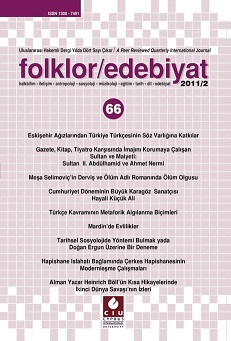Türkçe Kavramının Metaforik Algılanma Biçimleri
Metaphoric Conceptions Related to “Turkish” Concept
Author(s): İ. Seçkin AydınSubject(s): Lexis, Semantics, Pragmatics, Descriptive linguistics, Philology
Published by: Uluslararası Kıbrıs Üniversitesi
Keywords: metaphor; conception; Turkish preservice teachers;
Summary/Abstract: The metaphor which is used instead of different concepts such as metonymy, analogy, and figure of speech in Turkish constitutes one of the most important data collection tools of qualitative researches in recent times. Metaphor can be defined as expressing a concept or situation by another concept or situation. By this way, the concept we called as metaphor reveals “relevancy” inside itself. Metaphor transforms the concepts in terms of using the same concept or term as a language form as transition between different media. In this context, it seems as relevant with language and usage of language. However, the metaphors have more functions than this. Researchers state that the metaphors are useful to understand the individuals’ roles in instruction and teaching concepts, and in education. The aim of this research is to collect the metaphors related to “Turkish” concept created by Turkish preservice teachers who will acquire the language teaching as a profession; and to reveal their conceptions by classifying these collected metaphors under various categories. In the study, data were first evaluated by content analysis based on the qualitative research. Data collected from 185 students at the beginning had been read by two experts except the researcher, and the metaphors were encoded by them. The encoded metaphors were arranged in an alphabetical order. During encoding process, inapplicable data for the metaphoric logic were excluded from the content. In this context, 172 participants had produced 111 metaphors related to “Turkish” concept. The following conclusions can be stated as a result of this research: 1. “Turkish” presented itself mostly by its permanency and richness. In addition to this, it is seen that “Turkish” is a historical, national value, source of life, an aesthetical structure, and a mean of communication. 2. Although Turkish preservice teachers have a positive conception related to “Turkish”, communicative and artistic function of the language did not become prominent too much. The concepts related to the conception of the language given to the students beginning from the elementary school are very effective on their future life. This study done displays that Turkish preservice teachers still bear the traces of this process, and in this regard how effective is the education system on individuals’ conceptions of their own professions.
Journal: Folklor/Edebiyat
- Issue Year: 17/2011
- Issue No: 66
- Page Range: 173-187
- Page Count: 15
- Language: Turkish

